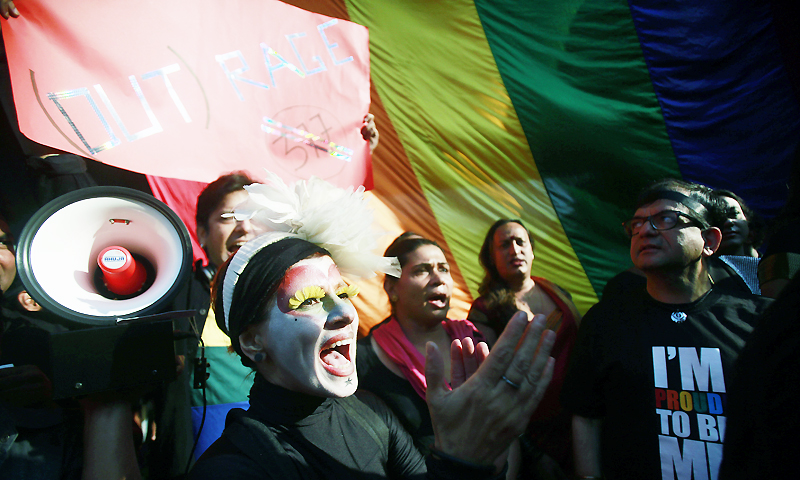by V. VENKATESAN, T.K. RAJALAKSHMI, & SAGNIK DUTTA
 In this Dec 15, 2013 file photo, Indian gay rights activists shout slogans during a protest against a Supreme Court verdict that upheld section 377 of the Indian Penal Code that criminalises homosexuality in Mumbai, India. Gay-rights activists and health workers in India are warning that a new Supreme Court ruling criminalising homosexuality will undo years of progress in fighting AIDS by driving gay and transgender people underground. PHOTO/AP/Dawn
In this Dec 15, 2013 file photo, Indian gay rights activists shout slogans during a protest against a Supreme Court verdict that upheld section 377 of the Indian Penal Code that criminalises homosexuality in Mumbai, India. Gay-rights activists and health workers in India are warning that a new Supreme Court ruling criminalising homosexuality will undo years of progress in fighting AIDS by driving gay and transgender people underground. PHOTO/AP/Dawn
The forenoon of Wednesday, December 11, 2013, will be remembered as a dark hour in the history of the Supreme Court of India. As Chief Justice P. Sathasivam and Justice Ganpat Singh Singhvi began the day’s proceedings at 10-30 a.m. in Court No.1, the significance of the two judges sitting together to hear the day’s matters was clear: Justice Singhvi was simply following the convention which requires that a retiring judge sit along with the Chief Justice on the last day of his office. However, none in the courtroom realised that Justice Singhvi, through his last judgment to be delivered on that day, was going to turn the clock of justice back by several decades.
The atmosphere in the courtroom was tense as litigants, their counsel, and mediapersons waited with bated breath for the verdict, almost 21 months after the final hearing in the Suresh Kumar Koushal vs Naz Foundation case got over. Justice Singhvi read out the operative portion of the judgment declaring that no constitutional infirmity was found in Section 377 of the Indian Penal Code (IPC) and that the Delhi High Court judgment decriminalising homosexuality had been set aside.
A Bench comprising Justice Singhvi and Justice Sudhansu Jyoti Mukhopadhaya not only held Section 377 constitutional but questioned the constitutional right of a sexual minority, the lesbian, gay, bisexual, and transgender (LGBT) community, to equality and justice and to the constitutional guarantees of life and liberty. Many—not just LGBTs—were appalled at the poor reasoning in Justice Singhvi’s judgment to arrive at his conclusions.
The IPC was drafted by Lord Macaulay and introduced in 1861 in British India. Section 377 of the IPC is contained in Chapter XVI titled “Of Offences Affecting the Human Body”. Within this Chapter, Section 377 is categorised under the sub-chapter titled “Of Unnatural Offences” and reads as follows:
“377. Unnatural Offences—Whoever voluntarily has carnal intercourse against the order of nature with any man, woman or animal, shall be punished with imprisonment for life, or with imprisonment of either description for a term which may extend to ten years, and shall also be liable to fine.
“Explanation—Penetration is sufficient to constitute the carnal intercourse necessary to the offence described in this section.”
The marginal note refers to the acts proscribed as “unnatural offences”. This expression, however, is not used in the text of the Section. The expression “carnal intercourse” is used in Section 377 as distinct from the expression “sexual intercourse”, which appears in Sections 375 and 497 of the IPC.
On July 2, 2009, a Bench comprising the then Chief Justice Ajit Prakash Shah and Justice S. Muralidhar of the Delhi High Court declared Section 377, insofar as it criminalises consensual sexual acts of adults in private, as violative of Articles 21, 14 and 15 of the Constitution. But the Bench added that the provisions of Section 377 would continue to govern non-consensual penile non-vaginal sex and penile non-vaginal sex involving minors.
A large number of organisations and individuals, including two who were interveners before the High Court, challenged the High Court judgment in the Supreme Court. During the pendency of the special leave petitions, the Supreme Court allowed several applicants to act as interveners.
The main petitioner, Suresh Kumar Koushal, an astrologer, himself was not a party in the case decided by the High Court. The court accepted his claim that as a citizen he had the moral responsibility and duty to protect the cultural values of Indian society and that as he believed that the High Court’s judgment in the case threatened those values, he had a right to appeal against it.
Frontline for more
